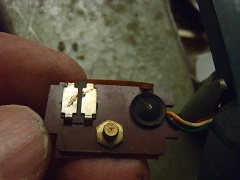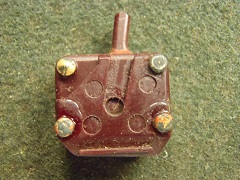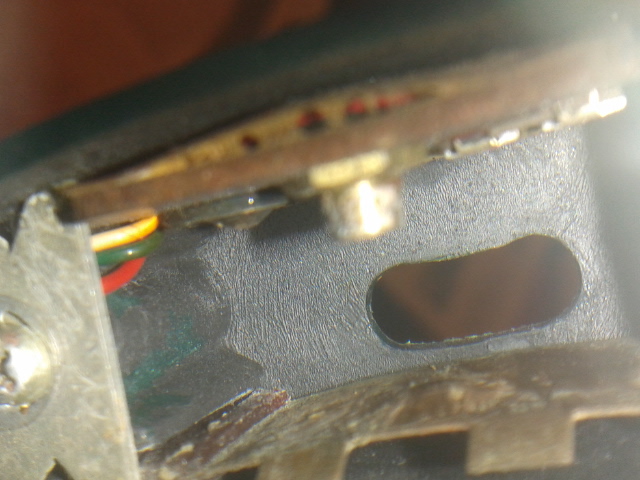Phono cartridge retro fit?
Posts: 122
Threads: 37
Joined: Jul 2012
City: Coral Springs, FL
Has anyone tried using a more modern phono needle cartridge in one of these old Philco phonographs? I'm going to attempt to rebuild by old (1954) phono cartridge - it uses a crystal element - but I was wondering if it would be possible to buy a more modern, efficient and better quality needle cartridge and retro fit it in the old tone arm.
Any input or experience with this is appreciated. Thanks.
Posts: 98
Threads: 2
Joined: Jul 2014
City: Eugene, OR
It can be done. I take it your 1954 changer is mono? If you plan on playing nothing but mono records you can probably use a Pfansteihl P-51 cartridge. You may also be able to upgrade to a stereo cartridge bridged for mono so that you can play stereo records with it. If you can provide the model number of your changer it will probably be easier to help you find a more modern cartridge that will fit it.
Posts: 122
Threads: 37
Joined: Jul 2012
City: Coral Springs, FL


Record changer is M24 and was used in 1953 and 1954 radio/phonographs. It uses a tilt cartridge with a double needle, one side for 78 rpm and the other side of the needle for 45 and 33 1/3 rpm records. The cartridge has two contact lugs, (these are the two at the top of the photo, the bottom two are just rivets and do not connect with anything), one as a ground and one to connect with the contact plate (see photo), one contact is for the 45 rpm needle and the other is for the 78 rpm needle. The black round contact on the contact plate is a ground for the ground lug on the cartridge. I used 400 sandpaper to clean off the black corrosion, which now makes a much better connection. The phonograph is mono. I would assume that I would have to make some sort of modification of the contact plate inside the tone arm to make the newer cartridge fit and work??
Photos attached show the side of the cartridge with the neg and positive contacts and the contact plate that is mounted in the tone arm. Thanks
(This post was last modified: 08-18-2015, 09:13 PM by ODPILOT.)
Posts: 98
Threads: 2
Joined: Jul 2014
City: Eugene, OR
How does it mount in the tone arm?
Posts: 122
Threads: 37
Joined: Jul 2012
City: Coral Springs, FL
Here's a picture of the tone arm without the needle cartridge in it. One side has the contact plate that also contains a metal stud that slides into a recessed area on the side of the needle cartridge, the other side inside the tone arm has a metal clip which exerts pressure on the needle cartridge to keep it snug against the contact plate. To remove the cartridge, I simply push the cartridge towards the metal clip side and just pull it down. To reinsert, I just push the cartridge back up into it and it snaps into place.

There are 3 wires that go into the contact plate, you can see them in the photo. Two are for the two different contacts for the 2 different needles, the third wire is a ground for the cartridge. The oval hole you see in the top of the tone arm is for the lever to at the top of the cartridge so that you can tilt the cartridge to the 78 side or the 45/33 side. I did look up the needle you mentioned above, I'm sure I can figure out a way to mount it in there and but would have to somehow solder and/or connect the leads from the new needle, because the old contact plate will work for the new needle. The little Philips head screw you see with the little metal plate (there's another one of these on the other side, not visible in the photo) are used to keep the contact plate and the spring plate from moving and/or falling out. I might be able to use those for somehow anchor the new needle?
(This post was last modified: 08-21-2015, 09:22 PM by ODPILOT.)
Posts: 98
Threads: 2
Joined: Jul 2014
City: Eugene, OR
It's probably similar to the cartridge in my M-22 but I have yet to tear into that so I'm not sure. Both are tilt cartridges though. You can try a Pfansteihl 226 or 228 which are stereo. Some new cartridges include the clips to attach the wires to the cartridge. You can solder the clips to the wires and then attach the clips to the cartridge. Never solder wires directly to the cartridge's pins! I agree you will have to get creative in mounting the new cartridge but I suppose that's part of the fun! The new cartridge will have a flip stylus which will render the button on top of the tone arm useless. You might contact Gary at the Voice of Music website and see if he can tell you which replacement would work best. He sells them all!
Posts: 122
Threads: 37
Joined: Jul 2012
City: Coral Springs, FL
Thank you very much - your info will definitely help.
Posts: 98
Threads: 2
Joined: Jul 2014
City: Eugene, OR
I just got home from vacation and had a look at the tilt cartridge in my M-22. It looks identical to yours. I haven't tested mine yet but chances are it's dead. I see that the styli are still available for it so I may try and rebuild mine. Not sure if I can do it, but it will be fun to try and if it doesn't work I can always go with a more modern replacement.
Posts: 122
Threads: 37
Joined: Jul 2012
City: Coral Springs, FL
Yes, I think the M22, M24, M24 A - all used the same exact tone arm, cartridge and stylus. I did talk to the people at V/M Enthusiasts, and he recommended for a replacement the Pfansteihl P51-3, but it only will play 78's and 45's (not 33 1/3). So he also recommended the EV 5632 HLF, part # DS73 as a replacement as well, since it has a flip needle and can play all speeds. I ordered one - let's see if I can make it fit into the old tone arm. Before I install it, I will try to rebuild the old cartridge as well - but it seems to be a very tedious task and am doubtful that I will be able to make it as good as new.
Posts: 98
Threads: 2
Joined: Jul 2014
City: Eugene, OR
I think he meant the P51-2 which has a compromise stylus of 2 mil and will play both 78's and microgroove records but probably isn't good for 33's. I have a P51-3 with a 3 mil stylus for 78's only. Anyway, good luck with the one he recommended! I opened my tilt cartridge and it looks like quite a project to rebuild it! It's pretty small so getting a small enough piezo element in there and getting it to work will be a tall order! I did some research and found out that the two contacts on the plate are there because the changer adjusts the output depending on the stylus and speed chosen. It plays 78's at a lower output than microgroove records. If we just decide to do away with the contact plate and wire in a newer ceramic cartridge, we will still have to address the output issue which is also controlled by the speed selector switch. It should be possible to bypass the output dropping system and play all records at the same level.
Posts: 122
Threads: 37
Joined: Jul 2012
City: Coral Springs, FL
I finally took some time and temporally connected by new phono cartridge (EV5632-Ast-DS73) from VM Audio Enthusiasts. It's a stereo ceramic cartridge with a red (right) , white (left) and silver connector wires. Gary Stork at VM told me to tie the red & white wires together if I wanted to use it on mono records (which I do). I used alligator clips to connect the wires from the new cartridge into the tone arm wires and held the wires just behind the cartridge and let it rest on it's own weight on an Al Jolson 78 record. Holy freakin crap - this new cartridge was crystal clear - 5X more response in clarity and volume than the old cartridge and the old cartridge had a buzz sound which is gone. I couldn't believe how good this thing sounds. Now I just have to figure out how to mount it inside the tone arm so it's held in there well, straight and with the capability of removing it if necessary. THANKS for your help on this - I had no idea the result of this "retro" fit would be so good. Cheers !!
Posts: 98
Threads: 2
Joined: Jul 2014
City: Eugene, OR
Thats great to hear! I've heard you can just stick the new cartridge into the tone arm with glue or even two way tape if there's no easy permanent solution. I will probably go with the same cartridge for my M-22 but first just for fun I'm growing my own Rochelle salt crystals to see if I can get the tilt cartridge working again. I've already grown some and if I can get the next batch to come out big enough (1/2"x-1/2") I should be able to do it. You have to put two sheets of crystal together so they can vibrate against each other to make a working piezo element. Like I said it's just for fun to see if I can actually get halfway decent sound out of it but in the end I'll most likely end up doing what you've done with the bridged stereo cartridge so I'll be able to play stereo LP's and 45's along with my 78's.
Posts: 122
Threads: 37
Joined: Jul 2012
City: Coral Springs, FL
[attachment=8245][attachment=8246]I didn't want to glue it in because if the cartridge ever has to be replaced, then you have a mess on your hands trying to get it out. Here's what I did. I took a thin strip of metal (it's from the metal cutting strip found inside the cardboard dispenser boxes for saran wrap, wax paper, etc). I cut it to length and drilled holes I opposite ends for the screws to mount it into the tone arm pre-existing screw slots. I bent it in such a way to allow the cartridge, once it's attached to the metal strip, to be angled so that the needle will contact the record without the rest of the cartridge hitting the record. The metal strip is very soft and pliable so now that I figured out the correct shape, I will duplicate it with a slightly thicker metal strip - like from flashing used in air conditioning - which you can buy in Home Depot or Lowes. The cartridge has a plastic mount which will be crazy glued to the metal strip and then the cartridge can slide in and out of the mount as needed for replacement. Took me a while to mess with the shape of metal strip to get it to fit and be angled just right. Here's a couple of pics.
Posts: 98
Threads: 2
Joined: Jul 2014
City: Eugene, OR
That's looking good! I haven't started on my 51-1330 yet so it will be awhile before I get to where you're at. I like what you did and will most likely do the same when the time comes.
Posts: 122
Threads: 37
Joined: Jul 2012
City: Coral Springs, FL
Hey there Squire - just a heads up when you do start working on your 51-1330 phono tone arm new cartridge. I made the mistake of creating the bracket in the tone arm such that the cartridge will be angled with the needle itself being lower that the rest of the cartridge. I was afraid the rest of the cartridge and needle flip lever would hit the record. However, this is wrong. I failed to consider that the tone arm itself is angled from where it pivots at the back of the phonograph. The end result I noticed was that with my angled cartridge and the pre existing natural angle of the tone arm, the needle was contacting the record at like a 40 degree angle. Although it sounds very good, I wonder if this would cause premature wear of the needle and/or grooves in the record. Therefore, I straightened out my little metal bracket so that the cartridge now sits level in the tone arm, and now that needle contacts the record at its normal angle. Live and learn - hope this helps when you get to yours. Cheers.
Users browsing this thread: 1 Guest(s)
|
|
Recent Posts
|
|
Testing a speaker and output transformer Trutone A2-G
|
| The equivalent of one short turn is basically the same as that of a shorted load.
If it is the primary's turn, then the ...morzh — 03:53 PM |
|
Testing a speaker and output transformer Trutone A2-G
|
| I've never had an output transformer become shorted, the failure mode is usually an open primary, or in a center tapped ...Arran — 03:52 PM |
|
Philco model 38 code 121 not receiving signal.
|
| As long as the plastic sheeting isn't too thick, I think that the thickness of photographic film would be just about rig...Arran — 03:19 PM |
|
Philco model 38 code 121 not receiving signal.
|
| Well why not! :lol:Stormlord5500 — 03:14 PM |
|
Philco model 38 code 121 not receiving signal.
|
| Good luck next thing you know you will be winding coils just for the fun of it. DavidDavid — 11:29 AM |
|
Testing a speaker and output transformer Trutone A2-G
|
| morzh
Short-circuited turns can be considered as a half-dead transformer.
But on this case transformer will hot and s...Vlad95 — 11:01 AM |
|
Testing a speaker and output transformer Trutone A2-G
|
| I am not sure how a transformer could be weak. It could be inadequate, but only when you replace the original with somet...morzh — 09:56 AM |
|
Philco model 38 code 121 not receiving signal.
|
| Good news everyone! I think I have found everything I need for rewinding the antenna coil primary.
I found some pla...Stormlord5500 — 09:40 AM |
|
Philco Battery-WWII vintage
|
| My younger sister went to SUNY Plattsburg NY, (BS, MS, RN) in the late 1970sabout 10 min from the Northern NY / Canada b...MrFixr55 — 07:59 AM |
|
Philco Battery-WWII vintage
|
| Hello Bob,
What Amazing find!
Sincerely Richardradiorich — 10:19 PM |
|
Who's Online
|
There are currently 2410 online users. [Complete List]
» 1 Member(s) | 2409 Guest(s)
|
|
|

|
 
|



![[-] [-]](https://philcoradio.com/phorum/images/bootbb/collapse.png)


